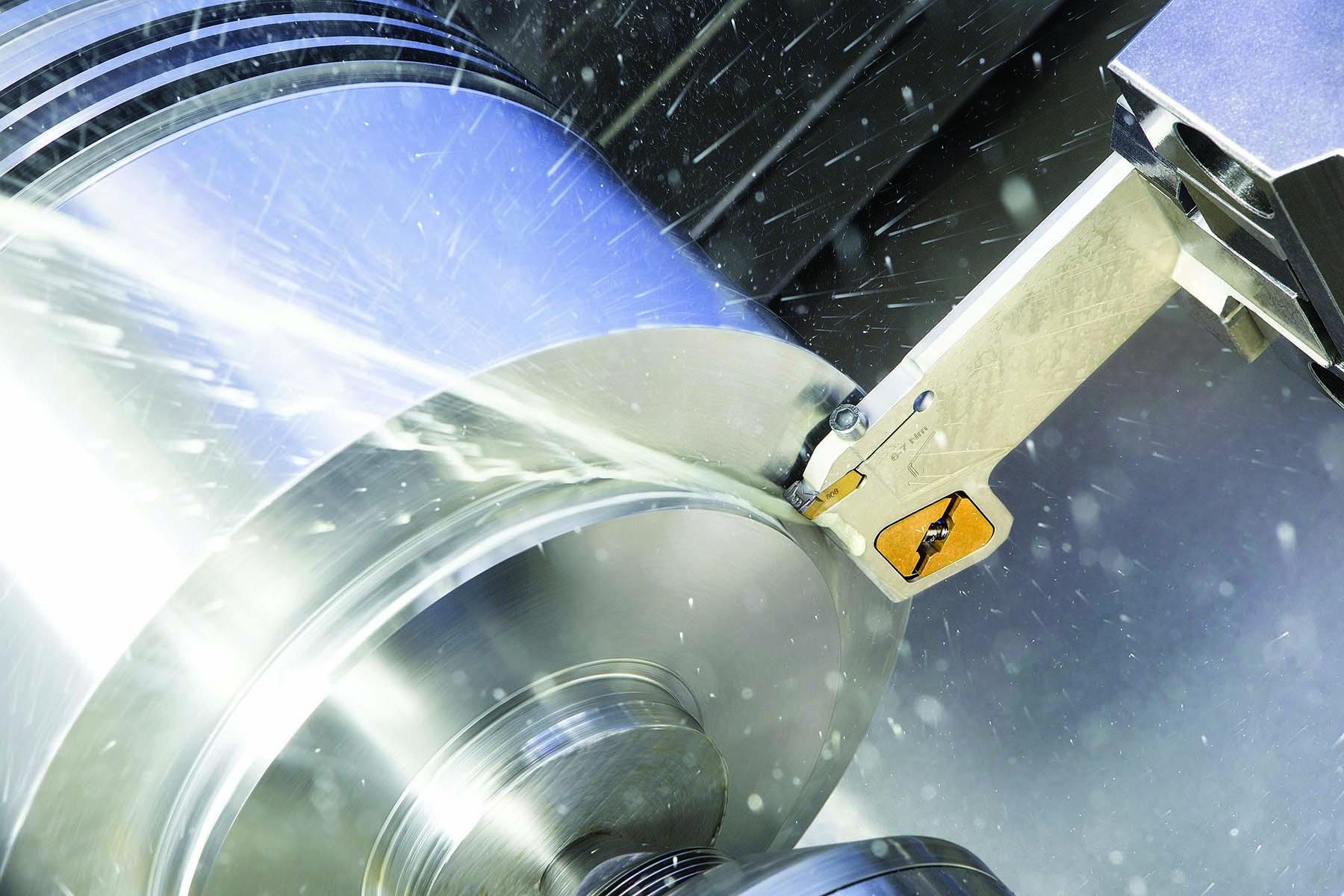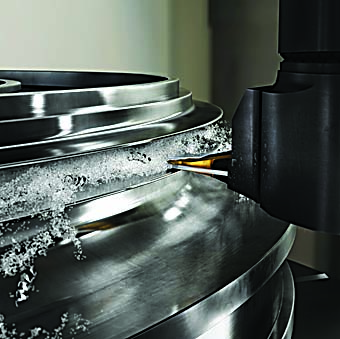When machining, specialty materials always have come with unique problems and solutions. With grooving specifically, working with materials like titanium alloys and heat-resistant superalloys is no exception. Experts have different suggestions for successful grooving but agree that it takes experience, the right tooling and patience.
Grooving falls into its own category in manufacturing. The process creates good clearances, offers flexibility and generates features that no other tooling can. Grooving even can run multiple operations with a single tool. The downside is that grooving doesn’t allow the same mechanical advantage as other methods. For example, a square tool is used to cut a round object that’s rotating quickly. This makes it more difficult to reliably hold the tool, perfectly line it up with the centerline of the rotating material and achieve a “perfect” groove. These challenges become even larger when specialty materials are introduced.
Physically Speaking
The physical differences among titanium alloys, HRSAs and “standard” materials, such as stainless steel and aluminum, go beyond what you might see if you look at them. Titanium alloys have high levels of nickel and chromium while HRSAs are exceptionally good at keeping heat away from material — a property that’s great in some situations but disastrous at a machine shop.

Due to these physical differences, titanium alloys and HRSAs cannot be cut reliably with the same tooling, speeds or even techniques as stock 6061 aluminum, for example. Sometimes people don’t understand these differences, so education can be hard. To address the first part of the equation, machinists need to combat the heat resilience of these materials.
Travis Coomer, national key account manager for Tavares, Florida-based GWS Tool Group, said it all comes down to how much heat is generated, where it goes and how it’s handled. Controlling heat is one of the main focuses of machining. That’s largely why feeds, speeds and tooling considerations matter in the first place.
“If you’re cutting HRSAs,” he said, “then the heat has only two places to go: the chip or the tool that is cutting.”
Machinists know that heat in a tool is rarely a good thing. It wears out tooling quicker and hurts machine performance. When tools wear out, they need to be replaced, which takes time and costs money.
While titanium alloys don’t feature the same heat resistance as HRSAs, they are equally as difficult to machine. Because the material is so much harder to cut due to the added nickel and chromium, extra heat and force are put into the grooving tool, shortening its life.
Tool chatter is another common issue while machining titanium alloys or HRSAs. With harder materials, more vibration is sent into the cutting head. This alters the precision of grooves and might lead to creating parts outside customer specifications.
Upgrading Tooling
For these problems, a best practice used across the industry is to opt for higher-tech tooling. Since it will be cutting into the material, shops prefer to use stronger, more durable, heat-resistant tooling.
Steve Vanderink, national product specialist for grip products at Arlington, Texas-based Iscar USA, pointed out tooling changes that improve the ability to groove specialty materials. He mentioned switching to submicron carbide tooling, thin physical vapor deposition coatings, high-sheer chipformers and coolant upgrades.
These upgraded tooling changes solve the problems associated with grooving titanium and HRSAs. Heat is diverted away from the tool, which allows cutters to last longer, produce more reliable results and reduce overall downtime. The trade-off is that these tooling changes cost a lot more than a traditional grooving tool that a shop might use to cut aluminum. It also means that shops without these tools can’t consistently groove specialty materials like titanium and HRSAs — creating a divide with shops that offer grooving.
All these technical advances help prolong tool life. Submicron carbide and PVD coatings improve the cutting ability and physical characteristics of tooling, permitting a tool to wear slower when it works on difficult materials like titanium. Better chipformers keep hot chips away from the material and tooling.
High-quality tooling used to cut HRSAs might have built-in holes and channels to support flowing coolant during machining. Keeping heat away from the tool and out of the part is a big focus in creating a good groove. With the introduction of coolant that was supplied directly through the cutting tool, heat became better controlled, letting tools last longer.
Further Innovation
Vanderink mentioned the importance of specialty tooling grippers and named Iscar’s Heli-Grip, Whisper-IQ-Grip, Sumo-Grip and Dove-IQ-Grip — four tools used in four different scenarios.
The Sumo-Grip, for instance, has grooving blades with no top jaw. This allows better chip evacuation, keeping heat away from the part and tool. Also, for example, the Whisper-IQ-Grip changes how the cutting tool is held, permitting deeper grooves into titanium without additional chatter or tool breakage.

“High-quality, application-specific tooling with very specific characteristics is needed if a shop wants to machine successfully,” Vanderink said.
Working With Customers
Another part of the puzzle comes from customers. Whenever a shop works with specialty materials, the design of the part needs to be considered carefully. It’s also imperative that the customer understands the budgetary differences. Running titanium alloys requires a machine to cut slower, feed material slower and take more frequent breaks. These differences result in more time and attention on the machine, leading to higher quoted prices and longer turnaround times.
One option is to turn to a simpler solution: utilizing off-the-shelf goods. Often, determining if this is viable means having upfront conversations with the designer on the team at the customer, said Scott Lewis, aerospace industry specialist at Mebane, North Carolina-based Sandvik Coromant Co. In his experience, customers commonly need extra help when designing grooves for specialty materials. He said with more information at the start, suggestions can be made to save time and money and avoid customization.
A custom tooling solution might be required but often is unnecessary. Sometimes if a designer makes slight changes to a model, an off-the-shelf product can be used instead, which typically is preferred.
“Listen to the customer, and understand what they’re looking for,” Lewis said. “Show them what you offer (in terms of) tools and support services.”
He said doing so can cut down the quote and shed weeks from the total process.
Vanderink echoes that message.
“Provide a technical engineer to assist — or even better, partner up — with the customer’s application,” he said.
By receiving this level of guidance, a customer can understand better what options are available.
Lewis and Vanderink urge manufacturers to remember that customers might not have any knowledge of how titanium alloys and HRSAs react during grooving. Something simple to do with 304 stainless steel may require specialty inserts and tooling. If a designer has experience only with more generic metals, he or she will design a piece accordingly.
Through a combination of improved communication, specialized inserts, upgraded tooling and better coolant flow, shops can offer grooving options for titanium and HRSAs that were previously impossible. Better yet, shops can provide these solutions at more competitive prices and with faster turnaround times.
Contact Details
Contact Details
Contact Details
Related Glossary Terms
- alloys
alloys
Substances having metallic properties and being composed of two or more chemical elements of which at least one is a metal.
- chatter
chatter
Condition of vibration involving the machine, workpiece and cutting tool. Once this condition arises, it is often self-sustaining until the problem is corrected. Chatter can be identified when lines or grooves appear at regular intervals in the workpiece. These lines or grooves are caused by the teeth of the cutter as they vibrate in and out of the workpiece and their spacing depends on the frequency of vibration.
- coolant
coolant
Fluid that reduces temperature buildup at the tool/workpiece interface during machining. Normally takes the form of a liquid such as soluble or chemical mixtures (semisynthetic, synthetic) but can be pressurized air or other gas. Because of water’s ability to absorb great quantities of heat, it is widely used as a coolant and vehicle for various cutting compounds, with the water-to-compound ratio varying with the machining task. See cutting fluid; semisynthetic cutting fluid; soluble-oil cutting fluid; synthetic cutting fluid.
- feed
feed
Rate of change of position of the tool as a whole, relative to the workpiece while cutting.
- grooving
grooving
Machining grooves and shallow channels. Example: grooving ball-bearing raceways. Typically performed by tools that are capable of light cuts at high feed rates. Imparts high-quality finish.
- physical vapor deposition ( PVD)
physical vapor deposition ( PVD)
Tool-coating process performed at low temperature (500° C), compared to chemical vapor deposition (1,000° C). Employs electric field to generate necessary heat for depositing coating on a tool’s surface. See CVD, chemical vapor deposition.
- physical vapor deposition ( PVD)2
physical vapor deposition ( PVD)
Tool-coating process performed at low temperature (500° C), compared to chemical vapor deposition (1,000° C). Employs electric field to generate necessary heat for depositing coating on a tool’s surface. See CVD, chemical vapor deposition.
- superalloys
superalloys
Tough, difficult-to-machine alloys; includes Hastelloy, Inconel and Monel. Many are nickel-base metals.
Contributors
GWS Tool Group
877-497-8665
www.gwstoolgroup.com
Iscar USA
888-472-2788
www.iscarmetals.com
Sandvik Coromant Co.
800-726-3845
www.sandvik.coromant.com





